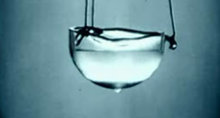Liquid helium

At standard pressure, the chemical element helium exists in a liquid form only at the extremely low temperature of −269 °C (about 4 K or −452.2 °F). Its boiling point and critical point depend on which isotope of helium is present: the common isotope helium-4 or the rare isotope helium-3. These are the only two stable isotopes of helium. See the table below for the values of these physical quantities. The density of liquid helium-4 at its boiling point and a pressure of one atmosphere (101.3 kilopascals) is about 0.125 grams per cm3, or about 1/8th the density of liquid water.[1]
Liquefaction
Helium was first liquefied on July 10, 1908, by the Dutch physicist Heike Kamerlingh Onnes at the University of Leiden in the Netherlands.[2] At that time, helium-3 was unknown because the mass spectrometer had not yet been invented. In more recent decades, liquid helium has been used as a cryogenic refrigerant, and liquid helium is produced commercially for use in superconducting magnets such as those used in magnetic resonance imaging (MRI), nuclear magnetic resonance (NMR), Magnetoencephalography (MEG), and experiments in physics, such as low temperature Mössbauer spectroscopy.
Characteristics
The temperature required to produce liquid helium is low because of the weakness of the attractions between the helium atoms. These interatomic forces in helium are weak to begin with because helium is a noble gas, but the interatomic attractions are reduced even more by the effects of quantum mechanics. These are significant in helium because of its low atomic mass of about four atomic mass units. The zero point energy of liquid helium is less if its atoms are less confined by their neighbors. Hence in liquid helium, its ground state energy can decrease by a naturally-occurring increase in its average interatomic distance. However at greater distances, the effects of the interatomic forces in helium are even weaker.[3]
Because of the very weak interatomic forces in helium, this element would remain a liquid at atmospheric pressure all the way from its liquefaction point down to absolute zero. Liquid helium solidifies only under very low temperatures and great pressures. At temperatures below their liquefaction points, both helium-4 and helium-3 undergo transitions to superfluids. (See the table below.)[3]
Liquid helium-4 and the rare helium-3 are not completely miscible.[4] Below 0.9 kelvin at their saturated vapor pressure, a mixture of the two isotopes undergoes a phase separation into a normal fluid (mostly helium-3) that floats on a denser superfluid consisting mostly of helium-4.[citation needed] This phase separation happens because the overall mass of liquid helium can reduce its thermodynamic enthalpy by separating.
At extremely low temperatures, the superfluid phase, rich in helium-4, can contain up to 6% of helium-3 in solution. This makes possible the small-scale use of the dilution refrigerator, which is capable of reaching temperatures of a few millikelvins.[4][5]
Superfluid helium-4 has substantially different properties from ordinary liquid helium.
Data
| Properties of liquid helium | Helium-4 | Helium-3 |
|---|---|---|
| Critical temperature[3] | 5.2 K | 3.3 K |
| Boiling point at one atmosphere[3] | 4.2 K | 3.2 K |
| Minimum melting pressure[6] | 25 atm | 29 atm at 0.3 K |
| Superfluid transition temperature at saturated vapor pressure | 2.17 K[7] | 1 mK in the absence of a magnetic field[8] |
Gallery
-
Liquid helium (in a vacuum bottle) at 4.2 K and 1 atm, boiling slowly.
-
Lambda point transition: as the liquid is cooled down through 2.17 K, the boiling suddenly becomes violent for a moment.
-
Superfluid phase at temperature below 2.17 K. In this state, the thermal conductivity is extremely high. This causes heat in the body of the liquid to be transferred to its surface so quickly that vaporization takes place only at the free surface of the liquid. Thus, there are no gas bubbles in the body of the liquid.
See also
References
- ^ "The Observed Properties of Liquid Helium at the Saturated Vapor Pressure". University of Oregon. 2004.
- ^ Wilks, p. 7
- ^ a b c d Wilks, p. 1.
- ^ a b D. O. Edwards; D. F. Brewer; P. Seligman; M. Skertic; M. Yaqub (1965). "Solubility of He3 in Liquid He4 at 0°K". Phys. Rev. Lett. 15 (20): 773. Bibcode:1965PhRvL..15..773E. doi:10.1103/PhysRevLett.15.773.
{{cite journal}}: Unknown parameter|last-author-amp=ignored (|name-list-style=suggested) (help) - ^ Wilks, p. 244.
- ^ Wilks, pp. 474–478.
- ^ Wilks, p. 289.
- ^ Dieter Vollhart; Peter Wölfle (1990). The Superfluid Phases of Helium 3. Taylor and Francis. p. 3.
{{cite book}}: Unknown parameter|lastauthoramp=ignored (|name-list-style=suggested) (help)
- General
- J. Wilks (1967). The Properties of Liquid and Solid Helium. Oxford: Clarendon Press. ISBN 0-19-851245-7.
- Freezing Physics: Heike Kamerlingh Onnes and the Quest for Cold, Van Delft Dirk (2007). Edita - The Publishing House Of The Royal Netherlands Academy of Arts and Sciences. ISBN 978-90-6984-519-7.



